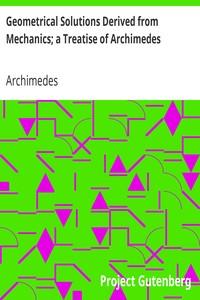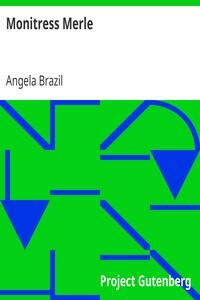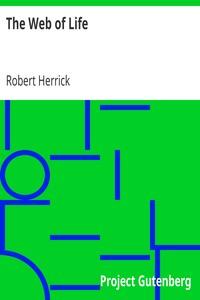Read this ebook for free! No credit card needed, absolutely nothing to pay.
Words: 13304 in 4 pages
This is an ebook sharing website. You can read the uploaded ebooks for free here. No credit cards needed, nothing to pay. If you want to own a digital copy of the ebook, or want to read offline with your favorite ebook-reader, then you can choose to buy and download the ebook.


: Geometrical Solutions Derived from Mechanics; a Treatise of Archimedes by Archimedes BCE BCE Smith David Eugene Author Of Introduction Etc Heiberg J L Johan Ludvig Translator Robinson Lydia Gillingham Translator - Geometry Early works to 1800 Mathematics
Edition: 10
Gordon Keener
% gbn0305181551: Archimedes, Geometrical Solutions Derived from Mechanics. Gordon Keener <gkeener@nc.rr.com>. 1909c. 5/19/2003. ok. documentclass usepackage usepackage usepackage
title
author
date \ Dr. J. L. Heiberg\ \ vspace \ David Eugene Smith\ \ vspace \ Lydia G. Robinson\ \ vspace }
begin
maketitle
vfillpagebreak
If there ever was a case of appropriateness in discovery, the finding of this manuscript in the summer of 1906 was one. In the first place it was appropriate that the discovery should be made in Constantinople, since it was here that the West received its first manuscripts of the other extant works, nine in number, of the great Syracusan. It was furthermore appropriate that the discovery should be made by Professor Heiberg, emph among all workers in the field of editing the classics of Greek mathematics, and an indefatigable searcher of the libraries of Europe for manuscripts to aid him in perfecting his labors. And finally it was most appropriate that this work should appear at a time when the affiliation of pure and applied mathematics is becoming so generally recognized all over the world. We are sometimes led to feel, in considering isolated cases, that the great contributors of the past have worked in the field of pure mathematics alone, and the saying of Plutarch that Archimedes felt that ``every kind of art connected with daily needs was ignoble and vulgar''footnote may have strengthened this feeling. It therefore assists us in properly orientating ourselves to read another treatise from the greatest mathematician of antiquity that sets clearly before us his indebtedness to the mechanical applications of his subject.
A second feature of much interest in the treatise is the intimate view that we have into the workings of the mind of the author. It must always be remembered that Archimedes was primarily a discoverer, and not primarily a compiler as were Euclid, Apollonios, and Nicomachos. Therefore to have him follow up his first communication of theorems to Eratosthenes by a statement of his mental processes in reaching his conclusions is not merely a contribution to mathematics but one to education as well. Particularly is this true in the following statement, which may well be kept in mind in the present day: ``l have thought it well to analyse and lay down for you in this same book a peculiar method by means of which it will be possible for you to derive instruction as to how certain mathematical questions may be investigated by means of mechanics. And I am convinced that this is equally profitable in demonstrating a proposition itself; for much that was made evident to me through the medium of mechanics was later proved by means of geometry, because the treatment by the former method had not yet been established by way of a demonstration. For of course it is easier to establish a proof if one has in this way previously obtained a conception of the questions, than for him to seek it without such a preliminary notion. . . . Indeed I assume that some one among the investigators of to-day or in the future will discover by the method here set forth still other propositions which have not yet occurred to us.'' Perhaps in all the history of mathematics no such prophetic truth was ever put into words. It would almost seem as if Archimedes must have seen as in a vision the methods of Galileo, Cavalieri, Pascal, Newton, and many of the other great makers of the mathematics of the Renaissance and the present time.
Proposition II states no new fact. Essentially it means that if a sphere, cylinder, and cone have the same radius, $r$, and the altitude of the cone is $r$ and that of the cylinder r$, then the volumes will be as : 1 : 6$, which is true, since they are respectively $fracpi r^3$, $fracpi r^3$, and pi r^3$. The interesting thing, however, is the method pursued, the derivation of geometric truths from principles of mechanics. There is, too, in every sentence, a little suggestion of Cavalieri, an anticipation by nearly two thousand years of the work of the greatest immediate precursor of Newton. And the geometric imagination that Archimedes shows in the last sentence is also noteworthy as one of the interesting features of this work: ``After I had thus perceived that a sphere is four times as large as the cone. . . it occurred to me that the surface of a sphere is four times as great as its largest circle, in which I proceeded from the idea that just as a circle is equal to a triangle whose base is the periphery of the circle, and whose altitude is equal to its radius, so a sphere is equal to a cone whose base is the same as the surface of the sphere and whose altitude is equal to the radius of the sphere.'' As a bit of generalization this throws a good deal of light on the workings of Archimedes's mind.
Free books android app tbrJar TBR JAR Read Free books online gutenberg
More posts by @FreeBooks


: An Enquiry into an Origin of Honour; and the Usefulness of Christianity in War by Mandeville Bernard - Honor







